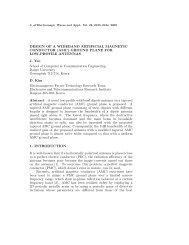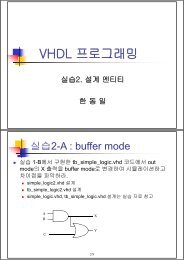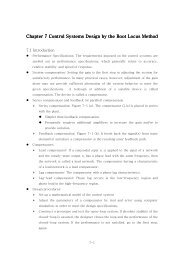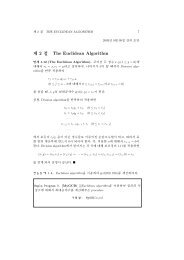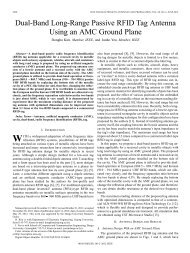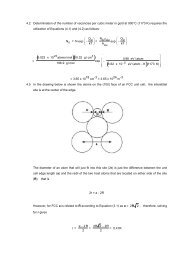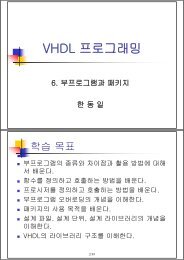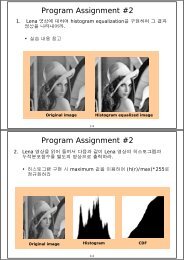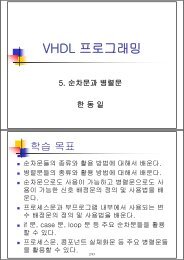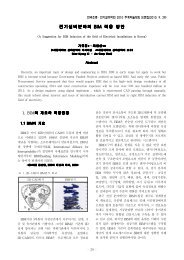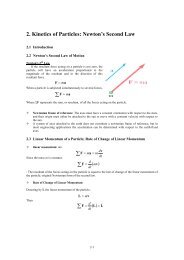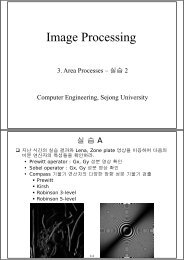UNIQUENESS OF ROOTS UP TO CONJUGACY FOR SOME ...
UNIQUENESS OF ROOTS UP TO CONJUGACY FOR SOME ...
UNIQUENESS OF ROOTS UP TO CONJUGACY FOR SOME ...
You also want an ePaper? Increase the reach of your titles
YUMPU automatically turns print PDFs into web optimized ePapers that Google loves.
8 EON-KYUNG LEE AND SANG-JIN LEE<br />
(a) α = σ −1<br />
2 σ2 1σ −1<br />
2 σ−2 1 σ−1 2 σ−2 1 σ 3σ 2 σ 2 1σ 2 σ 3 (b) β = 〈α〉 n for n = (3, 1, 1, 2)<br />
Figure 7. For the above 4-braid α, we have lk 2 (α) = 0, lk 3 (α) = −1, lk 4 (α) = 1,<br />
hence lk(α) = 0+(−1)+1 = 0. For the above 7-braid β, we have lk 2 (β) = lk 3 (α) =<br />
0, lk 4 (β) = 0, lk 5 (β) = −1, lk 6 (β) = lk 7 (α) = 1, hence lk(β) = 1.<br />
Definition 2.12. For a braid α ∈ B n,1 and an integer 2 ≤ i ≤ n, we define the i-th linking number<br />
lk i (α) of α as the linking number between the first and the i-th strands of α. See Figure 7.<br />
The following is an obvious relation between the linking number and the i-th linking number.<br />
Lemma 2.13. Let α = 〈α 0 〉 n (α 1 ⊕ α 2 ⊕ · · · ⊕ α r ) n ∈ B n,1 for a composition n = (n 1 , . . . , n r ) of<br />
n. Then lk(α) = lk(α 1 ) + ∑ r<br />
i=2 n i lk i (α 0 ).<br />
Definition 2.14. For a set P ⊂ {1, 2, . . . , n} and a composition n = (n 1 , . . . , n r ) of n, define the<br />
sets P n,0 , P n,1 , . . . , P n,r as follows:<br />
P n,i = {1 ≤ j ≤ n i | (n 1 + · · · + n i−1 ) + j ∈ P } for i = 1, . . . , r;<br />
P n,0 = {1 ≤ i ≤ r | P n,i ≠ ∅}.<br />
Note that, using the above notations, P = ⋃ r<br />
i=1 ((n 1 + · · · + n i−1 ) + P n,i ). The following lemma<br />
is easy.<br />
Lemma 2.15. Let P ⊂ {1, 2, . . . , n} and α = 〈α 0 〉 n (α 1 ⊕ · · · ⊕ α r ) n for a composition n of n.<br />
(i) α is P -pure if and only if α i ’s are P n,i -pure for all i = 0, 1, . . . , r.<br />
(ii) α is P -straight if and only if α i ’s are P n,i -straight for all i = 0, 1, . . . , r.<br />
(iii) If α 1 is 1-unlinked, then (α 1 ⊕ · · · ⊕ α r ) n is 1-unlinked.<br />
3. Uniqueness of roots up to conjugacy<br />
In this section, we prove Theorem 1.6. Let us explain our strategy for proof. Suppose we<br />
are given P -pure braids α and β such that α k = β k for some nonzero integer k. Note that α<br />
is either pseudo-Anosov, or periodic, or reducible and non-periodic. Lemma 3.2 deals with the<br />
case where α is pseudo-Anosov or periodic. Now, suppose α is reducible and non-periodic. There<br />
are three cases: α ext is pseudo-Anosov; α ext is central; α ext is periodic and non-central. (Here<br />
α ext is a particular tubular braid of α. See Definition 3.3.) If α ext is either pseudo-Anosov or<br />
central, we may assume α ext = β ext , and this case is resolved in Lemma 3.4. For the case where<br />
α ext is periodic and non-central, we construct a P -straight conjugating element from α to β, and<br />
then modify this conjugating element in order to make it 1-unlinked. Lemma 3.6 is useful in this<br />
modification. In the end we give the proof of Theorem 1.6. Due to the lemmas mentioned above,<br />
it suffices to construct a P -straight conjugating element from α to β for the case where α ext is<br />
periodic and non-central.<br />
From now on, we will say that Theorem 1.6 is true for (α, β, P, k) if (α, β, P, k) is given as in<br />
Theorem 1.6 and there exists a P -straight, 1-unlinked braid γ with β = γαγ −1 .



